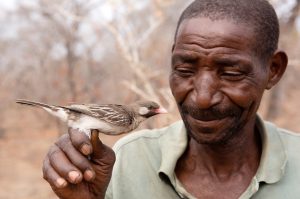BIRDS LEAD HUMANS TO HONEY
By Mitch Leslie

Yao honey hunter Seliano Rucunua holds a male honeyguide caught for research in the Niassa Special Reserve in Mozambique. CLAIRE SPOTTISWOODE
When people in the Niassa Special Reserve of northern Mozambique hanker for something sweet, they don’t call DoorDash or Uber Eats. They call a bird. The aptly named honeyguide will lead them to a bee nest so they can harvest the honey. The bird obtains a treat, too—scrumptious wax and bee larvae. A new study suggests this partnership, which occurs in several places in Africa, is even more intricate than scientists thought. People in different regions make unique sounds to summon the birds, and the birds recognize and respond to calls from their local area, researchers report today in Science. The authors say the results suggest humans and honeyguides shape each other’s cultural traditions.
“It’s an elegant study. The results are so clear, and the experimental design is so simple,” says ethologist Julia Hyland Bruno of the New Jersey Institute of Technology, who wasn’t connected to the work.
Scientists have documented just a handful of cases in which humans cooperate with wild animals. For example, in Brazil, Myanmar, and India, people and dolphins work together to catch fish. But the alliance between honey-seeking people and honeyguides in Africa takes collaboration to a higher level. The small, brown-and-white birds are adept at finding bee nests and remembering their locations. “They learn the landscape intimately,” says behavioral ecologist Claire Spottiswoode of the University of Cambridge, a co-author on the new paper. Humans, in turn, chop open the trees where the nests are located and smoke out the furious bees. The two species often split the spoils, but honey hunters sometimes stiff their assistants, destroying the wax so the birds are motivated to look for more nests.
Honeyguides sometimes solicit people to follow them, but honey hunters can also invite the birds to help. The Yao people who live in the Niassa Special Reserve, for instance, make a distinctive “brrrr” sound, followed by a “huh” that rises in pitch.
The sounds people use to draw the birds differ from place to place. Can the birds tell the difference? To find out, Spottiswoode teamed up with anthropologist Brian Wood of the University of California, Los Angeles, who has been studying the Hadza community of northern Tanzania for almost 20 years. The Hadza rely on complex whistles that are, as Wood puts it, “almost like an orchestra of melodies” to notify the birds they are ready to look for honey.
At sites in Tanzania and Mozambique, researchers and honey hunters tramped through the bush playing recordings of the Yao calls, Hadza whistles, or humans yelling their names, which served as a control. In Tanzania, honeyguides were more than three times more likely to hook up with a group playing the Hadza whistles than with one playing the Yao call or the shouts. And in Mozambique, a playback of the Yao call was more than twice as effective as the other two sounds. The researchers ruled out the possibility that the birds opted for a particular sound because it was easier to hear in that environment, determining that the calls and whistles faded equally rapidly in the two locations. The DNA of the birds doesn’t differ from place to place, but the calls can change over relatively short distances, which suggests the honeyguides don’t inherit their preference, Spottiswoode says. A more likely explanation is that “the birds learn to respond to the signals of their local human partners.”
Like humans, birds can have their own cultures, often passed down through their songs. The new findings suggest honeyguides and humans reinforce each other’s traditions. Yao and Hadza honey hunters told the researchers that they stick with the calls they learned from their forebears because changing them reduces the odds of attracting honeyguides. The birds apparently figure out that the call of their area means an opportunity for food, and they are drawn to people making it. But they don’t respond the same way to an unfamiliar call, which discourages honey hunters from innovating. Whether the honeyguides learn to respond to the local call from other honeyguides or on their own is a question the researchers want to investigate.

Yao honey hunters use fire and tools to harvest a bees’ nest in the Niassa Special Reserve in Mozambique. CLAIRE SPOTTISWOODE
“They provide really clear evidence for the interaction between honeyguides and humans and the possibility for learning by the birds,” says behavioral ecologist Mauricio Cantor of Oregon State University, who wasn’t connected to the study. “They’ve done an elegant job of demonstrating that there is cultural variation here,” adds behavioral ecologist Stephen Nowicki of Duke University. Humans cooperate and communicate with domesticated animals all the time, “but this is a wild animal. To see the complexity of communication that can occur—that’s really unusual.” As the authors note, fewer people are hunting for honey because they can now buy sugar. That decline could affect the birds, notes ornithologist John Marzluff of the University of Washington. “If you are a species cooperating with us, you have to be on your game because we change rapidly.”
Humans are making massive changes to the planet and threatening biodiversity, but the birds provide a positive example of an animal that can live alongside people, Wood says. Their “ability to learn opens up possibilities for cooperation and coexistence.”
We are here to share current happenings in the bee industry. Bee Culture gathers and shares articles published by outside sources. For more information about this specific article, please visit the original publish source: Birds that lead people to honey recognize local calls from their human helpers | Science | AAAS








